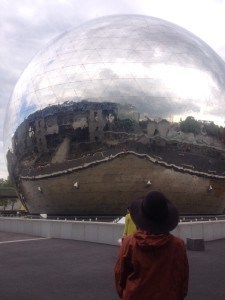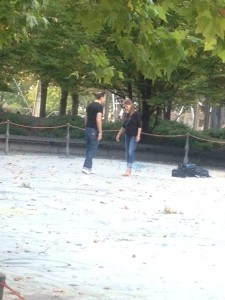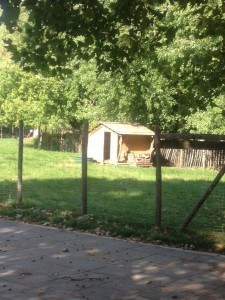Like most once-industrial areas now used as a place of recreation and residence, the 19th arrondissement’s main water feature – a system of canals based on augmenting l’Ourcq, an existing stream-cum-watercourse, with water from the Seine, that took centuries to fully realise – has been subject to the impulse to create a community development in the environmental arts. Of sorts.
Built on a site once occupied by the abattoirs of Paris, as different in topography and history as it can be from the Puna Quarry Park, this expansive, largely level, green and partly-wooded, space is, even though all but one of the abattoir buildings have gone, as highly adapted from its commercial and logistical functions into a community amenity as its antipodean counterpart. At La Villette, however, commercial activity and community still, on occasion, overlap in both form and function.  The Geode, a huge geodesic dome outside the Cite des Sciences et de l’Industrie does not dance
The Geode, a huge geodesic dome outside the Cite des Sciences et de l’Industrie does not dance  to the music of time, but it is the source of a series of sound sequences that, supposing you can wait and listen long enough to undo their aural algorithms, will enable you to establish the hour and minute of the day. This terrific, permanent, installation is not there merely to demonstrate visual and aural mathematics, however; it also functions as a theatre for 3-D movies, which must be quite an experience, coming at you, as they must, in the round. We did not enter the Geode, but from the outside it confirmed your correspondent’s slow-to-realise understanding that the essence of the best installation art is, actually, time. In this spirit, the TPC could not, as she did at the Louvre, merely glance and move on, and defend this as a legitimate response to the scale of the work on display. In made landscapes, such as either the Te Puna Quarry Park or the Parc de La Villette, the truest and best satisfaction comes from allowing time to pass while you are there. The Parc de la Villette has been designed around different choices as to how you might spend your time. On the one side, as you enter from the quaint but now disused lock of St Denis, is the largest science museum in Europe. In true spirit of inquiry, it’s also a place of play: like the Te Puna Quarry Park, it has a dragon playground: without a lawn.
to the music of time, but it is the source of a series of sound sequences that, supposing you can wait and listen long enough to undo their aural algorithms, will enable you to establish the hour and minute of the day. This terrific, permanent, installation is not there merely to demonstrate visual and aural mathematics, however; it also functions as a theatre for 3-D movies, which must be quite an experience, coming at you, as they must, in the round. We did not enter the Geode, but from the outside it confirmed your correspondent’s slow-to-realise understanding that the essence of the best installation art is, actually, time. In this spirit, the TPC could not, as she did at the Louvre, merely glance and move on, and defend this as a legitimate response to the scale of the work on display. In made landscapes, such as either the Te Puna Quarry Park or the Parc de La Villette, the truest and best satisfaction comes from allowing time to pass while you are there. The Parc de la Villette has been designed around different choices as to how you might spend your time. On the one side, as you enter from the quaint but now disused lock of St Denis, is the largest science museum in Europe. In true spirit of inquiry, it’s also a place of play: like the Te Puna Quarry Park, it has a dragon playground: without a lawn.
 The other part, defined by a huge, and still functioning, canal bridged at top and bottom by steel-grey and red, uncompromisingly geometric, structures, is the precinct for music and ecology. The TPC’s envy levels soared as she contemplated the live performing arts opportunities on offer here. As well as the Geode’s movies, the Parc provides (she is indebted to Wikipedia for the following list): Cité de la musique (City of Music), a museum of historical musical instruments with a concert hall, also home of the Conservatoire de Paris; Le Zénith, a concert arena with 6,300 seats; Cabaret Sauvage, a flexible small concert stage with 600 to 1,200 seats; Le Trabendo, a contemporary venue for pop, rock, folk music, and jazz with 700 seats; Le TARMAC (former Théâtre de l’Est Parisien), venue for world performance art and dance companies touring from “La Francophonie”; Le Hall de la Chanson (at Pavillon du Charolais), theatre dedicated to French song with 140 seats WIP Villette, “Work In Progress–Maison de la Villette,” a space dedicated to Hip-Hop culture, social theatre, art work initiatives, and cultural democracy; Espace Chapiteaux, a 4200 m² permanent space under a tent for contemporary circus, resident and touring companies perform; Pavillon Paul-Delouvrier, a chic contemporary event space for conferences,
The other part, defined by a huge, and still functioning, canal bridged at top and bottom by steel-grey and red, uncompromisingly geometric, structures, is the precinct for music and ecology. The TPC’s envy levels soared as she contemplated the live performing arts opportunities on offer here. As well as the Geode’s movies, the Parc provides (she is indebted to Wikipedia for the following list): Cité de la musique (City of Music), a museum of historical musical instruments with a concert hall, also home of the Conservatoire de Paris; Le Zénith, a concert arena with 6,300 seats; Cabaret Sauvage, a flexible small concert stage with 600 to 1,200 seats; Le Trabendo, a contemporary venue for pop, rock, folk music, and jazz with 700 seats; Le TARMAC (former Théâtre de l’Est Parisien), venue for world performance art and dance companies touring from “La Francophonie”; Le Hall de la Chanson (at Pavillon du Charolais), theatre dedicated to French song with 140 seats WIP Villette, “Work In Progress–Maison de la Villette,” a space dedicated to Hip-Hop culture, social theatre, art work initiatives, and cultural democracy; Espace Chapiteaux, a 4200 m² permanent space under a tent for contemporary circus, resident and touring companies perform; Pavillon Paul-Delouvrier, a chic contemporary event space for conferences,
workshops, and social events designed by Oscar Tusquets; Théâtre Parc-Villette, a small actors’ theatre and acting workshop with 211 seats; Cinéma en plein air, an outdoor movie theatre, site of an annual film festival; Grande halle de la Villette, a historical cast iron & glass abattoir that now holds fairs, festive cultural events, and other programming; Centre équestre de la Villette, equestrian center with numerous year-round events; Philharmonie de Paris, a new symphony hall with 2,400 seats for orchestral works, jazz, and world music designed by Jean Nouvel, opened since January 2015. So it was particularly satisfying to come upon our own private dancers, working on their tango routine right alongside an ecological experiment developing pasturage for heritage sheep from the Auvergne. (Alas, no sheep at this warm time of the year, but we did see their dear little house.) The village of La Villette
right alongside an ecological experiment developing pasturage for heritage sheep from the Auvergne. (Alas, no sheep at this warm time of the year, but we did see their dear little house.) The village of La Villette  was joined to the city of Paris rather late in the day, as might also be expected of Te Puna’s relationship with Tauranga. The founding father for the process, Paul Delouvrier, Prefect of the Paris Region, is commemorated just outside the TPC’s hotel. We hope that, like most founding
was joined to the city of Paris rather late in the day, as might also be expected of Te Puna’s relationship with Tauranga. The founding father for the process, Paul Delouvrier, Prefect of the Paris Region, is commemorated just outside the TPC’s hotel. We hope that, like most founding  persons, he happily expected his creation to be very different in time from the way things were in his day. (“I’ll be dead before it’s finished!” happily observes the Quarry Park’s creator…..) And it is obscurely comforting to know that the effort Shirley and the TPC put into our explorations of this third-largest park in Paris was, like the philosophy behind the creation of the Quarry Park, intended. Our object was a quiet hour to spend in a music museum after a stroll across a city park. We walked, and walked, and sought directions, and walked some more. We could see the handsome black, pierced screen building; we got close enough almost to touch it; but could we find a way to its entrance? Reader, we could not. According, again, to Wiki: “The park embodies anti-tourism, not allowing visitors to breeze through the site and pick and choose the sites they want to see. Upon arrival in the park, visitors are thrust into a world that is not defined by conventional architectural relationships. The frame of the park, due to its roots in deconstructivism, tries to change and react to the functions that it holds within.” Reader, we felt it.
persons, he happily expected his creation to be very different in time from the way things were in his day. (“I’ll be dead before it’s finished!” happily observes the Quarry Park’s creator…..) And it is obscurely comforting to know that the effort Shirley and the TPC put into our explorations of this third-largest park in Paris was, like the philosophy behind the creation of the Quarry Park, intended. Our object was a quiet hour to spend in a music museum after a stroll across a city park. We walked, and walked, and sought directions, and walked some more. We could see the handsome black, pierced screen building; we got close enough almost to touch it; but could we find a way to its entrance? Reader, we could not. According, again, to Wiki: “The park embodies anti-tourism, not allowing visitors to breeze through the site and pick and choose the sites they want to see. Upon arrival in the park, visitors are thrust into a world that is not defined by conventional architectural relationships. The frame of the park, due to its roots in deconstructivism, tries to change and react to the functions that it holds within.” Reader, we felt it.
The Te Puna Correspondent. The Te Puna Correspondent, our rurally living, culturally eclectic reviewer of arts and culture in Tauranga, the Bay of Plenty.





